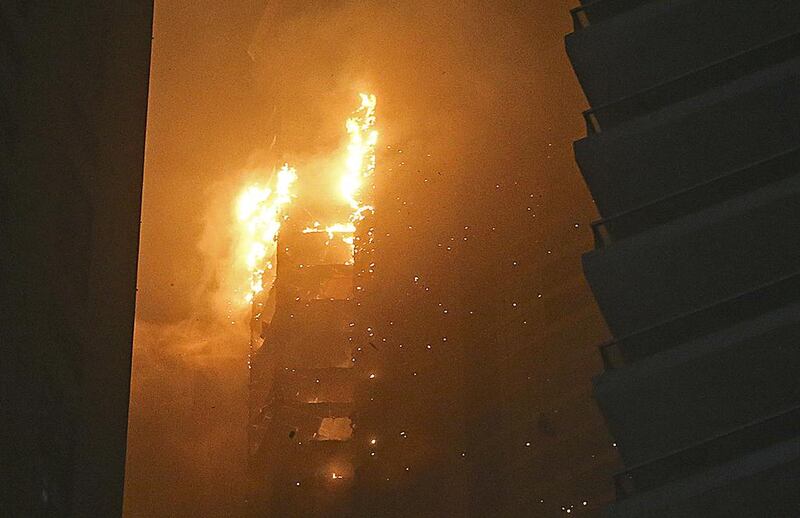Once the world’s tallest residential building, The Torch, lived up to its name and again made headlines around the world last month when a huge fire set the 1,105 foot tall building ablaze.
Despite dramatic videos of the inferno being beamed across the internet, fortunately no-one was harmed in the incident and Kingfield Owner Association Management Services, the building’s management company, last week reported that the structure of the tower had not been affected by the fire while “most of the damage was limited to the exterior cladding”.
But as Dubai Civil Defence begins the painstaking work of investigating what caused the blaze, cleaners remove the debris and many residents return to their homes, the dramatic fire footage has once again ignited long-standing concerns about the sort of cladding used in Dubai towers.
It is far too early to speculate on what caused the Torch fire last month.
However, parallels are being drawn with the 34-storey Tamweel Tower fire in Tecom in 2012, where a stray cigarette butt was found to have caused aluminium cladding panels to burn downwards, leaving tenants homeless.
Flammable cladding materials, comprising plastic or polyurethane fillings – called a thermo-plastic core – sandwiched between aluminium panels, have been blamed for spreading fires at both the Al Baker Tower 4 and the Al Tayer Tower in Sharjah in 2012.
Experts believe the majority of Dubai’s approximately 250 high-rise buildings use cladding panels with a thermo-plastic core, which have been generally used for insulation, to improve rigidity and for cosmetic purposes .
The 2012 blazes prompted the Ministry of Interior to introduce an extension to the emirate’s Fire and Life safety code requiring cladding for new buildings to adhere to tough new fire safety regulations and outlawing the use of foamed plastic insulation.
And in 2013 Civil Defence chiefs announced an extension to existing fire safety codes requiring owners of high-rise buildings with flammable cladding to install a ring of fire retardant panels every three floors, to stop fires spreading, and external sprinklers. The managers of the 86-storey Torch, which comprises 676 apartments and six shops, are quick to point out that the building adhered to all Dubai fire safety requirements when it was completed in May 2011.
“The Torch Tower was built strictly to code and all approvals from relevant authorities were obtained prior to the completion certificate being issued by the authorities,” says Kingfield Owner Association Management Services.
But for buildings’ insurers, who have to bear the costs of expensive claims in the event of a fire, the use of aluminium composite panels in towers is of growing concern – and that makes the properties harder to insure.
“What we look at in a building is whether these panels are extensively used or if they are used up to a reasonable amount,” says A K Ravindran, the technical director at RSA Insurance.
“So if a building has less than 50 per cent of its cladding made up of these panels we don’t consider it a great risk to underwrite,” he says. “We do categorisation for up to 10 per cent, 10 to 20 per cent, 20 per cent to 50 per cent and above 50 per cent.
“It enables us to evaluate our exposure in these segments. Generally what we notice is that more than 50 per cent is not a manageable risk to underwrite.”
Mr Ravindran estimates that at least 30 per cent of the buildings RSA insures in Dubai contain aluminium panels “in some form or other” – especially those in areas such as JLT and Dubai Marina.
He says that for those with the highest proportion of panels, insurance options are limited.
“We don’t insure many buildings with more than 50 per cent foam panels,” he says.
“Most of the insurance companies look into the fire exposure quite keenly. This is an issue which is faced by all the insurance companies.
“There will definitely be a few buildings which will be completely uninsurable. Owners of these buildings will have to improve the quality of their buildings.”
Oman Insurance Company, the main insurer of the Torch Tower, declines to comment on its policy for insuring buildings clad in aluminium composite panels.
“As one of the leading insurers in the region, in the business for nearly 40 years, we have reinsurance support,” a spokeswoman says.
Meanwhile, for buildings that include non-regulated foam panel cladding, property experts are advising caution.
“Each building is built differently,” says Christopher Seymour, the head of property at the building consultancy EC Harris. “There have been fires in Dubai where it was suggested that the fire spread was to have been around the specification of the foam core in the sandwich cladding panels. The regulations which came into force into in 2012 updated that specification.
“The normal thing to do for buildings completed before the new codes came in would be to have a technical assessment on the building to assess these risks,” Mr Seymour adds.
“We certainly wouldn’t be saying that every building which has that sort of cladding is a fire risk.”
Mr Ravindran agrees. “At the end of the day for us it’s all about risk management,” he says.
“Glass cladding also is not a perfect solution as there is also a risk that fire can spread from one floor to another,” he points out.
“We look closely at how well the building’s management controls activities such as smoking and maintains the building.”
In the meantime, Torch residents will be grateful the building’s evacuation procedures were effective and the Dubai emergency services’ expertise helped to prevent further distress.
lbarnard@thenational.ae






